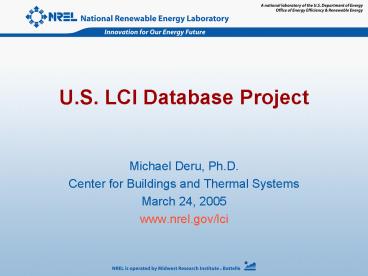U'S' LCI Database Project - PowerPoint PPT Presentation
1 / 28
Title:
U'S' LCI Database Project
Description:
Vehicle Recycling Partnership transformations ... Recycling/Waste Management. Use/reuse/Maintenance. Secondary Manufacturing. Life Cycle Stages ... – PowerPoint PPT presentation
Number of Views:90
Avg rating:3.0/5.0
Title: U'S' LCI Database Project
1
U.S. LCI Database Project
- Michael Deru, Ph.D.
- Center for Buildings and Thermal Systems
- March 24, 2005
- www.nrel.gov/lci
2
Project Objective
- Develop a publicly available life cycle inventory
(LCI) database for commonly used materials,
products, and processes
3
Motivation
- Growing demand for more scientific assessment of
environmental impact - Life-cycle analysis (LCA) is the best tool for
environmental impact assessment - LCA quality depends on the quality of LCI data
- Currently, there is no publicly available source
of LCI data in the U.S.
4
What is LCI and LCA?
- LCI is an accounting of the material and energy
flows into and out of the environment - LCA is a tool for the systematic evaluation of
the environmental aspects of a product or service
system cradle-to-cradle
5
Generic LCA Model
6
Project Organization
Advisory Board
7
Three-Phase Project
- I - Initiation Phase (2001-2002) (Completed)
- Develop research guidelines and parameters
- Prepare Phase II work program
- II Inventory (2002-2004) (Completed)
- Collect, analyze, and review LCI data
- III Long-term support
- Continued expansion of the database
- Disseminate data
- Maintain database
8
Funding and Support
- Government for Phase I
- DOE GSA
- Government and private sector for Phases II III
- DOE, GSA, EPA, Navy, USDA
- NIST agricultural products
- Vehicle Recycling Partnership transformations
- Consortium for Research on Renewable Industrial
Materials (CORRIM) wood products - American Plastics Council resins
- FY04 private support exceeded public support
9
Expected Users and Uses
- Developers of LCA tools
- For LCA practitioners (SimaPro, TEAM, )
- For non-practitioners (Athena EIE, BEES)
- Product assessment and labeling
- Manufacturers researchers for specific product
or process LCAs
10
Key Database Criteria
- Consistent protocol following ISO standards
- transparent
- representative
- peer reviewed
- Uniform treatment of all materials
- Regional data development as necessary
- Fully accessible in format(s) to maximize use
11
Data Format
- EcoSpold built on ISO 14048, SPOLD, SPINE
- EcoSpold import being implemented by major LCA
tool developers - SimaPro, GaBi, Umberto
- International data exchange (e.g., with Swiss
EcoInvent data) - Export formats
- EcoSpold XML
- EcoSpold Spreadsheet
- Streamlined Spreadsheet
- Detailed Spreadsheet
12
Cradle-to-Gate Focus
Resource extraction Recycled materials
Material Acquisition
Primary Manufacturing
Life Cycle Stages
Secondary Manufacturing
Use/reuse/Maintenance
Recycling/Waste Management
13
Working With Data Modules
14
Using the Results
15
Use by Manufacturers
16
Long-Term Benchmarking Validation
17
Website www.nrel.gov/lci
18
Resource Page
- Users Guide
- How to guide for data users and suppliers
- Data Development Guidelines
- Guide for data suppliers
- Streamlined Spreadsheet Template
- Blank spreadsheet for data suppliers
19
View Module Module Info Page
20
View Module Flow Info Page
21
Download Module Page
22
Available Data Modules (57)
23
Modules Under Development
- Plastic resins and polyurethane precursors
- Materials for durables production
- Steel from integrated mills
- Building and construction products
- Additional wood products and adhesives
- Transformations
- Plastic fabrication
- Steel stamping
- Bio-based products
24
Related Efforts
- LCA in LEED
- US Green Building Council using LCA to improve
rating system - U.S. LCI Database is preferred source of data
- Athena Environmental Impact Estimator will be
compatible with the U.S. LCI Database - BEES is switching to U.S. LCI Database data
- NIST is developing agricultural LCI data that
will be added to the database when appropriate
25
Support of EERE Programs
FEMP Sustainability
Distributed Energy Energy Emissions benefits
Geothermal Emissions benefits
Buildings Energy Materials Analysis
Hydrogen Analysis of Production Use
LCI Database
Biomass Analysis of Production Use
Industrial Technologies Improved Manufacturing
Solar Energy Improve Production Calculate
Benefits
Wind Hydropower Emissions benefits
Vehicles Fuels and Materials Analysis
Weatherization Intergovernmental
Programs Sustainability
26
Short-Term Priorities
- Develop business plan
- Form advisory board
- Build broad support
- Implement critical review process
- Revise database interface
- Expand database
27
Longer-Term Priorities
- Add data following Phase II work plan priorities
- Maintenance
- Continual up-dates - how often?
- Coordinate with related efforts
28
Questions
- www.nrel.gov/lci































